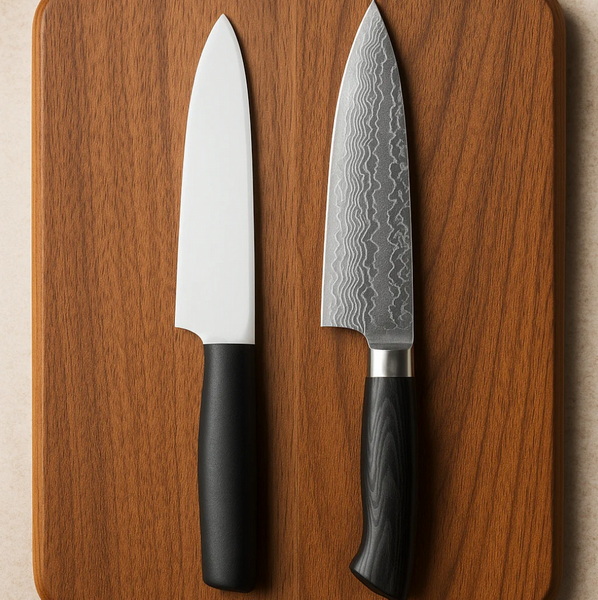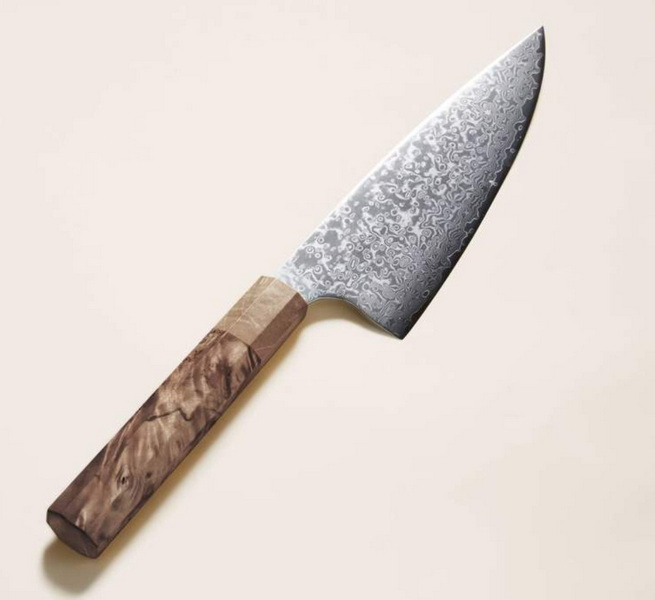- All
- Product Name
- Product Keyword
- Product Model
- Product Summary
- Product Description
- Multi Field Search
Views: 222 Author: Ann Publish Time: 2025-10-15 Origin: Site











Content Menu
● Introduction to Damascus and Ceramic Knives
● Cutting Performance and Sharpness
>> Damascus Knife: Precision and Flexibility
>> Ceramic Knife: Long-Lasting Sharpness but Brittle
>> Damascus Knife: Durable and Repairable
>> Ceramic Knife: Long-Lasting Edge but Care-Intensive
● Additional Considerations for Buyers
>> Safety
● Which Is Better for Your Kitchen?
● Frequently Asked Questions (FAQs)
>> 1. Are Damascus knives better than ceramic knives?
>> 2. Can ceramic knives be sharpened?
>> 3. Are Damascus knives rust-proof?
>> 4. Which knife is more suitable for everyday use?
>> 5. How do I care for a ceramic knife?
Choosing the right kitchen knife is crucial for achieving professional results in food preparation. Among the diverse options available, Damascus knives and ceramic knives are two popular choices, each with unique advantages and disadvantages. This article delves into a detailed comparison of Damascus knives and ceramic knives, focusing on cutting performance, durability, maintenance, and aesthetic appeal, helping you determine which knife type is best suited for your culinary needs.

A Damascus knife is a high-end kitchen tool made from layered steels that create a distinctive, beautiful pattern on the blade surface. Renowned for their exceptional sharpness, strength, and aesthetic appeal, Damascus knives combine traditional craftsmanship with modern steel technology. The layered construction not only enhances durability but also results in a flexible, resilient blade capable of maintaining a sharp edge over extended periods.
Damascus knives are traditionally forged from two or more different types of steel, folded multiple times to create a patterned blade. This technique also reduces impurities and enhances the blade's mechanical properties. The core blade is typically made of high-carbon steel for sharpness, while softer layers provide toughness. This hybrid structure results in a blade that is strong yet flexible, resisting chipping and breaking under normal kitchen use.
A ceramic knife features a blade made from zirconium dioxide (ZrO2), a tough, hard ceramic material. Known for their exceptional sharpness and resistance to corrosion, ceramic knives are lightweight and maintain their edge much longer than steel blades. However, due to their brittleness, ceramic knives are more prone to chipping or breaking under certain conditions.
Ceramic knives are manufactured through a process called sintering, where zirconium oxide powder is compressed and heated to form a solid, hollow blade. This process creates an extremely hard material—much harder than steel—with a Mohs hardness scale rating of about 8.5. Nevertheless, the ceramic blade lacks flexibility, making it vulnerable to damage from impacts or improper use.
Damascus knives are celebrated for their remarkable sharpness. The layered structure allows for a razor-sharp edge with excellent retention, making them ideal for delicate slicing tasks. Additionally, Damascus steel's flexibility ensures that the blade can perform a variety of cutting techniques without easily chipping or deforming.
Because the blade is forged rather than stamped, it often has a more acute edge angle—typically between 15° to 20° per side—allowing for precise and controlled slicing. This accuracy is especially valued in professional kitchens where delicate cuts and intricate presentation are required. The edge retention depends on the steel used in the core but generally falls in a medium to high range for carbon steel Damascus blends.
Ceramic knives are typically sharper initially and retain their edge significantly longer than steel knives—up to ten times longer in some cases. Their ultra-hard zirconia blade creates a smooth, clean cut, especially suited for slicing fruits, vegetables, and boneless meats. However, they lack the flexibility of Damascus knives; when used on hard surfaces or frozen foods, they are more susceptible to chipping or breakage.
Ceramic knives have a very acute edge, often between 12° to 15°, which contributes to their remarkable slicing ability. They glide effortlessly through softer food items without crushing or bruising, resulting in cleaner cuts and less oxidation in foods like fruits. However, the sharpness comes with the tradeoff of fragility, and a snapped or chipped ceramic blade cannot be easily repaired.
A well-crafted Damascus steel blade offers a combination of hardness and flexibility, making it durable in daily use. While it may require periodic honing and occasional sharpening, the layered structure allows for easier resharpening compared to other high-end steels. It is also resistant to rust if properly maintained.
Damascus knives tend to withstand everyday kitchen challenges well, including cutting through tougher ingredients and resisting accidental drops better than ceramics. Their blades can be sharpened by most standard sharpening stones or professional services, and minor nicks can be filed down without compromising the blade's integrity.

Ceramic blades maintain their sharpness longer, which reduces the frequency of sharpening. However, they are much more brittle and prone to chipping or breaking if dropped or used improperly. Maintaining a ceramic knife involves careful handling and avoiding hard surfaces like bone or frozen foods. Resharpening requires professional services or specialized equipment, as DIY sharpening can damage the blade.
Due to their hardness, ceramic knives cannot be honed or sharpened using traditional tools. Professional sharpening often involves diamond abrasive tools, making the process more expensive and less accessible than sharpening steel knives. As such, ceramic knives work best in kitchens where delicate cuts are the norm and the risk of severe blade damage is minimized.
Damascus knives are renowned for their striking patterns and craftsmanship, often collectible as works of art. Each blade's unique layered pattern can include swirling, wave-like designs, adding beauty and prestige to the kitchen.
The craftsmanship behind Damascus knives often extends to the handle design, which may incorporate exotic woods, metals, or ergonomic shapes tailored for professionals. This combination of design and functionality makes Damascus knives not only practical tools but also showpieces.
Ceramic knives generally have a plain, matte finish with a uniform color—commonly black or white—with some models featuring decorative designs but less intricate than Damascus steel patterns. Their lightweight nature and clean lines appeal to users seeking a minimalist look in their kitchen tools. However, the plain aesthetic lacks the character and uniqueness of forged steel knives.
Damascus knives are usually premium-priced, reflecting their craftsmanship, materials, and aesthetic appeal. They offer excellent performance and durability, making them a worthwhile investment for serious chefs and home enthusiasts.
Ceramic knives tend to be less expensive initially but may incur costs for professional sharpening or replacement if chipped or broken. Their affordability and low maintenance make them suitable for casual cooks who prioritize convenience and sharpness over ruggedness.
Damascus knives, with their sharp but flexible blades and sturdy handles, provide a secure grip and tend to be safer in heavy-duty kitchen work. Ceramic knives, being brittle, require careful handling to avoid sudden breakage, which could cause injury.
Ceramic knives are significantly lighter than Damascus knives, reducing hand fatigue during prolonged use. Damascus knives have more heft, which some chefs prefer for controlled cutting and chopping.
Both knives do not react with acidic foods. However, ceramic knives are completely non-reactive and do not impart any metallic taste. Damascus knives, with proper stainless steel layers, resist corrosion and staining but still need to be dried thoroughly.
| Use Case | Damascus Knife | Ceramic Knife |
|---|---|---|
| Precise slicing of delicate foods | Excellent, due to sharpness and flexibility | Superior, maintains edge longer |
| Heavy-duty tasks (bones, frozen foods) | Good, with proper care | Not recommended, brittle and prone to chipping |
| Ease of maintenance | Moderate, requires polishing and honing | Low, but handle with care |
| Aesthetic appeal | High, attractive layered patterns | Minimal, simple appearance |
| Weight | Moderate to heavy | Very light |
| Safety | Safe with proper use | Requires cautious handling |
Choosing between a Damascus knife and a ceramic knife depends on your cooking style and priorities. Damascus knives excel in versatility, durability, and aesthetic appeal, making them ideal for professional and serious home cooks. They offer excellent cutting performance on various food types, superior toughness, and ease of maintenance.
On the other hand, ceramic knives provide unmatched sharpness and edge retention with minimal maintenance, especially suitable for slicing fruits, vegetables, and other soft foods. However, they require gentle handling due to their brittleness and higher risk of chipping.
By understanding these differences, kitchen users can select the knife that best fits their culinary habits—combining performance, maintenance, and safety considerations for an optimal cooking experience.

Damascus knives generally offer a better balance of sharpness, durability, and flexibility, making them more versatile for various kitchen tasks compared to ceramic knives, which are extremely sharp but brittle.
Yes, but they require professional sharpening services or specialized equipment. DIY sharpening is not recommended as it can damage the blade.
Damascus steel contains layers of different steels, some of which may rust if not properly maintained. Regular cleaning and oiling are essential to prevent corrosion.
Damascus knives are more suitable for everyday use due to their durability, flexibility, and ease of maintenance.
Handle with care, avoid dropping or using on hard surfaces, and have it professionally sharpened when needed to prolong its lifespan.
The Ultimate Professional Knives for Halal Butchery in Middle Eastern Kitchens
Chef Knife Size Guide: Choosing Between 6″, 8″, 10″, And 12″
Custom Knife Handles: How To Design A Chef Knife That Fits Your Hand Perfectly
Chef Knife Surface Treatments Guide: From Polished Migaki To Damascus Patterns
Inside Our Professional Knife Sample Room: Quality You Can See
Universal Knife Block Buying Guide: Modern Acrylic & ABS Knife Holders for Professional Kitchens
Universal Knife Block: The Complete Guide To Modern, Hygienic Knife Storage
The Complete Guide To Red Handle Knife Sets: Style Meets Functionality in The Kitchen
Professional Knives for Halal Butchery And Middle Eastern Cuisine